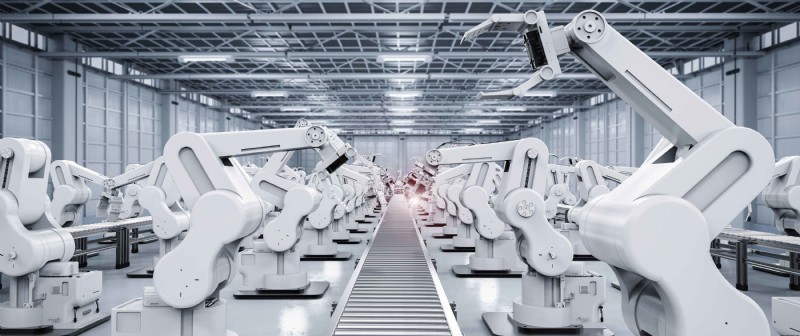산업용 로봇









자동화 솔루션 제공업체는 2021년에 시장에서 큰 변화를 겪었습니다. 코로나19 팬데믹은 산업 제조 외부를 포함하여 다양한 비즈니스 부문에서 자동화에 대한 수요를 창출했습니다. A3(Association for Advancing Automation)에서 발표한 통계에 따르면 북미 로봇 판매량은 2020년에 3.5% 증가했으며 계속해서 긍정적인 성장세를 보이고 있습니다. 팬데믹은 공급 부족, 새로운 안전 예방 조치, 큰 고용 격차와 같은 많은 문제를 비즈니스에 가져왔습니다. 기업은 이러한 문제를 극복하기 위해 더 높은 생산량을 가진 린 생산 프로세스를 개발하기 위해 비즈니스 모델과 공급망 관리를 재설계해야 했습니다. 많은 제품이 공급 부족에 직면한 상황에서 제조, 생명 과학, 식품 가공, 소매 및 배송/주문 처리와 같은 산업은 솔루션으로 자동화를 모색했습니다. 이것은 새로운 애플리케이션의 자동화와 일반 애플리케이션의 발전으로 이어졌습니다.
분류 및 정리 기술은 Covid-19 대유행으로 인한 의료 및 식량 공급 부족으로 인해 매출이 급증했습니다. 소비자 구매 습관의 급격한 변화는 산업 전반에 걸쳐 기업의 자동화 가치를 높였습니다. 애플리케이션 분류를 위한 자동화는 노동력 부족, 사회적 거리두기 요구 사항 및 기업의 공급망 점검을 위한 장기적인 솔루션을 제공합니다. 분류 애플리케이션으로 로봇 시장 수익이 증가하면서 비전 기반 분류 및 클린룸 로봇 공학과 같은 복잡하고 혁신적인 솔루션이 등장했습니다. 기업은 산업용 로봇과 함께 비전 및 머신 러닝을 사용하여 비전 기반 의사 결정이 포함된 분류 작업을 실행합니다. 로봇 회사들은 코팅을 위한 주사기 준비, 병에 알약을 넣고 뚜껑을 덮는 것, 식품 포장을 다루는 것과 같은 위생 작업이 필요한 환경을 위해 클린룸 로봇을 출시했습니다. 분류 로봇은 지속적으로 가시성을 확보하고 생산 운영 및 제품 산출량을 크게 개선할 수 있는 기능을 확장하고 있습니다.
품질 관리는 결함을 제거하고 고객이 기대에 부응하는 제품을 받을 수 있도록 하는 데 사용됩니다. 이 응용 프로그램은 제품 품질을 향상시키기 위해 모든 제조 산업에 적용됩니다. 최첨단 비전 기술은 자동화가 이 작업을 인계하고 개선할 수 있는 문을 열었습니다. 작업은 이제 새로운 영역에서 품질 관리를 구현하여 육안으로 볼 수 없는 결함을 제거할 수 있습니다. 이 기술의 예는 인간 작업자가 인식할 수 없는 색상 스펙트럼을 감지하는 스펙트럼 이미징입니다. 이 카메라는 신선 식품 검사에 사용되어 상품 내에서 상한 부분이나 이물질을 감지합니다. 부적절한 품질 검사로 인한 오류는 위험하고 비용이 많이 들며 회사 이미지에 해로울 수 있습니다. 비전 기술은 생산을 떠나는 모든 제품이 소비자에게 최고의 품질을 제공하도록 보장하는 추가 보안 계층을 제공합니다.
협동로봇이 코로나19 팬데믹 기간 동안 공장 폐쇄로 인해 2년 동안 실적 부진을 겪다가 복귀했다. 분류 애플리케이션 섹션에서 이전에 논의한 바와 같이 기업의 복구 단계에는 공급 부족 및 안전 제한에 대한 빠르고 효율적인 솔루션이 필요합니다. Companies are implementing collaborative technology in strategic ways to overcome employment gaps, social distancing restrictions, and the immediate need for leaner production processes. Some of the more popular uses of collaborative robots are for inspections, sorting, and packaging in collaboration with workers. Robot manufacturers, like Yaskawa, recently announced a new "Smart Series" cobot line that reduces research processes by providing investors with all the necessary accessories to guarantee fast setup. More industries are integrating cobots, manufacturing and non-manufacturing, as a quick and affordable turnkey solution.
The most significant influencer of supply chain industries has been the tremendous growth of e-commerce sales following the global pandemic. Robots are used across all parts of the supply chain, but as e-commerce fulfillment increases, mobile robots in warehouses and distribution centers are inevitable. These robots autonomously change routes without human intervention and can operate collaboratively with workers to perform tasks. In addition, technologies like voice-picking provide companies with faster production time and flexibility in workflow. Voice Picking is software that gives AMRs the capability to operate by giving verbal commands to the mobile robots. Companies using voice-picking AMRs report having immediate gain in productivity and savings with annual labor costs. The notoriety of mobile robots is exploding because of the flexible task handling they provide that other automation solutions and manual labor do not.
The recent surge in automation was a response to overcome supply shortages caused by COVID-19. The drastic increase in demand within such a short time frame made it difficult for suppliers to keep up without automating. Last year, in 2020, A3 reported robot orders from life science industries increased by a momentous 69% compared to the previous year. Market analysts project that life science industries, among other sectors, will continue to see more companies automating within the next few years. With more investments being put into automation, advancements will come at a quicker rate. Automation is now blending traditional industrial robots with IoT (Internet of Things) technology to create lean production processes further and collect data for the systems to improve efficiency autonomously. Converging these two technologies into one system that physically automates and digitally records data that can be used for machine learning and improving processes. Future automation will feature more of this blended technology, offering consumers cutting-edge automation to further enhance their supply chain process.
산업용 로봇
모든 제조 시설의 바닥에 있는 가장 정교한 기계는 로봇일 가능성이 높습니다. 로봇은 조립 라인, 특히 자동차 산업에서 처음 실용화된 이후로 사용되어 왔습니다. 이 기계는 휴식을 취하지 않고 특정 작업을 반복적으로 수행할 수 있도록 설계되었습니다. 일부 제조업체에서는 로봇을 하루 24시간, 주 7일 가동하고 간헐적인 유지보수를 위해서만 멈추는 것은 드문 일이 아닙니다. 산업용 로봇이 가져온 가장 큰 이점은 매번 일관된 결과를 제공할 수 있다는 것입니다. 산업용 로봇이 지속적으로 우수한 결과를 제공할 수 있다는 사실은 많은 제조업체가
산업용 로봇은 수십 가지의 다양한 애플리케이션을 수행할 수 있으며 일부 생산 라인에서는 제품이 완성되기 전에 여러 가지 애플리케이션이 필요할 수 있습니다. 그렇다면 3D 비전 시스템을 통합할 위치를 어떻게 결정합니까? 이러한 종류의 기술에서 어떤 응용 프로그램이 가장 많은 이점을 얻을 수 있습니까? 다음은 레이저 비전 시스템과 3D의 통합으로 큰 이점을 얻을 수 있는 몇 가지 응용 프로그램 목록입니다. 많은 전문가들은 3D 비전 시스템이 자재 취급 애플리케이션에 가장 적합하다고 생각합니다. 사실, 목록의 처음 세 개는 빈 피킹,